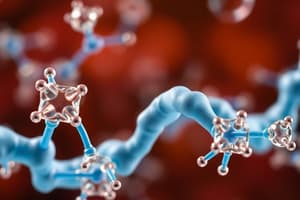Podcast
Questions and Answers
What is the primary function of carbohydrates in living organisms?
What is the primary function of carbohydrates in living organisms?
- Signaling molecules
- Catalysts for biochemical reactions
- Energy source and structural components (correct)
- Genetic information storage
Which level of protein structure refers to the overall three-dimensional shape of a single polypeptide chain?
Which level of protein structure refers to the overall three-dimensional shape of a single polypeptide chain?
- Secondary structure
- Primary structure
- Quaternary structure
- Tertiary structure (correct)
What is a key result of the Citric Acid Cycle?
What is a key result of the Citric Acid Cycle?
- Generation of glucose
- Formation of ribonucleic acids
- Lactate production
- Acetyl-CoA oxidation (correct)
Which process is NOT directly involved in energy production through cellular respiration?
Which process is NOT directly involved in energy production through cellular respiration?
What is the role of enzymes in biochemical reactions?
What is the role of enzymes in biochemical reactions?
Which technique is primarily used for analyzing the size and charge of proteins?
Which technique is primarily used for analyzing the size and charge of proteins?
Which statement about nucleic acids is incorrect?
Which statement about nucleic acids is incorrect?
In photosynthesis, which molecules are produced as a result?
In photosynthesis, which molecules are produced as a result?
Which of the following factors does NOT significantly affect enzyme activity?
Which of the following factors does NOT significantly affect enzyme activity?
Which process directly synthesizes RNA from a DNA template?
Which process directly synthesizes RNA from a DNA template?
Flashcards are hidden until you start studying
Study Notes
Overview of Biochemistry
- Study of the chemical processes within and related to living organisms.
- Interdisciplinary field combining biology and chemistry.
Major Biomolecules
-
Carbohydrates
- Composed of carbon, hydrogen, and oxygen (C, H, O).
- Functions: energy source, structural components (e.g., cellulose in plants).
- Types: monosaccharides (glucose), disaccharides (sucrose), polysaccharides (starch, glycogen).
-
Proteins
- Made of amino acids linked by peptide bonds.
- Functions: catalysis (enzymes), structure (collagen), transport (hemoglobin), signaling (hormones).
- Structure levels: primary (amino acid sequence), secondary (alpha helix, beta sheet), tertiary (3D structure), quaternary (multiple polypeptides).
-
Lipids
- Hydrophobic molecules including fats, oils, and steroids.
- Functions: energy storage, membrane structure (phospholipids), signaling (hormones).
- Types: triglycerides, phospholipids, sterols.
-
Nucleic Acids
- DNA and RNA, composed of nucleotides.
- Functions: genetic information storage (DNA), protein synthesis (RNA).
- Structure: double helix (DNA), single strand (RNA).
Key Metabolic Pathways
- Glycolysis: Breakdown of glucose to pyruvate for energy production.
- Citric Acid Cycle (Krebs Cycle): Oxidation of acetyl-CoA for ATP, NADH, FADH2 production.
- Oxidative Phosphorylation: ATP generation through electron transport chain and chemiosmosis.
Enzymes
- Biological catalysts that speed up chemical reactions.
- Specificity: enzymes are substrate-specific.
- Factors affecting enzyme activity: temperature, pH, substrate concentration, enzyme concentration.
Cellular Processes
- Cellular Respiration: Process of converting biochemical energy from nutrients into ATP.
- Photosynthesis: Conversion of solar energy into chemical energy in plants, producing glucose and oxygen.
Genetic Biochemistry
- DNA Replication: Process of copying DNA for cell division.
- Transcription: Synthesis of RNA from a DNA template.
- Translation: Process of synthesizing proteins from RNA sequences.
Techniques in Biochemistry
- Chromatography: Separation of biomolecules based on size, charge, or affinity.
- Electrophoresis: Method for analyzing DNA, RNA, or proteins based on size and charge.
- Mass Spectrometry: Technique for determining the composition of biomolecules.
Applications of Biochemistry
- Medicine: Understanding disease mechanisms, drug development.
- Biotechnology: Genetic engineering, enzyme technology.
- Agriculture: Development of pest-resistant crops and biofuels.
Overview of Biochemistry
- Biochemistry studies the chemical processes in living organisms, merging biology and chemistry.
Major Biomolecules
-
Carbohydrates:
- Composed of carbon, hydrogen, and oxygen (C, H, O).
- Serve as energy sources and structural components; e.g., cellulose in plants.
- Types include monosaccharides (e.g., glucose), disaccharides (e.g., sucrose), and polysaccharides (e.g., starch, glycogen).
-
Proteins:
- Made of amino acids connected by peptide bonds.
- Functions include catalysis (enzymes), structural support (collagen), transport (hemoglobin), and signaling (hormones).
- Structure levels:
- Primary: amino acid sequence.
- Secondary: alpha helix and beta sheet formations.
- Tertiary: three-dimensional conformation.
- Quaternary: assembly of multiple polypeptides.
-
Lipids:
- Hydrophobic molecules encompassing fats, oils, and steroids.
- Functions involve energy storage, constructing membranes (phospholipids), and signaling.
- Types include triglycerides, phospholipids, and sterols.
-
Nucleic Acids:
- DNA and RNA are constructed from nucleotides.
- DNA stores genetic information, while RNA is crucial for protein synthesis.
- Structural forms: DNA is a double helix; RNA is typically single-stranded.
Key Metabolic Pathways
- Glycolysis: Converts glucose into pyruvate, yielding energy in the form of ATP.
- Citric Acid Cycle (Krebs Cycle): Processes acetyl-CoA, generating ATP, NADH, and FADH2 through oxidation.
- Oxidative Phosphorylation: Involves ATP production using an electron transport chain and chemiosmosis.
Enzymes
- Act as biological catalysts, accelerating chemical reactions.
- Display specificity for substrates they act upon.
- Enzyme activity is influenced by temperature, pH, substrate concentration, and enzyme concentration.
Cellular Processes
- Cellular Respiration: Converts biochemical energy from nutrients into ATP, essential for cell functions.
- Photosynthesis: Transforms solar energy into chemical energy, producing glucose and oxygen in plants.
Genetic Biochemistry
- DNA Replication: Mechanism to duplicate DNA prior to cell division.
- Transcription: The process of synthesizing RNA from a DNA template.
- Translation: Synthesizes proteins from RNA sequences.
Techniques in Biochemistry
- Chromatography: Separates biomolecules by size, charge, or affinity.
- Electrophoresis: Analyzes DNA, RNA, or proteins based on their size and charge.
- Mass Spectrometry: Determines the molecular composition of biomolecules.
Applications of Biochemistry
- Medicine: Enhances understanding of disease mechanisms and aids in drug development.
- Biotechnology: Includes genetic engineering and enzyme technology for various applications.
- Agriculture: Focuses on creating pest-resistant crops and developing biofuels.
Studying That Suits You
Use AI to generate personalized quizzes and flashcards to suit your learning preferences.




